The passive safety system (SRS) of the car combines front and side airbags for the driver and passenger in the front seat, inflatable side curtains (depending on configuration), inertial seat belts for the driver and all passengers
The seat belts for the driver and front passenger are equipped with pyrotechnic pretensioners installed in inertial coils.

Airbags do not replace seat belts.
Moreover, when the car is moving, the driver and front passenger must be sure to wear their seat belts, since in the event of a traffic accident, a deployed airbag itself can cause serious injury to a person who is not wearing a seat belt.
In addition, passengers in the rear seat must be fastened with seat belts.
In the event of an accident, an unbelted passenger in the rear seat can cause injury and serious injury to all passengers in the vehicle.
Do not install or place any accessories on the front panel in front of the passenger above the glove box in the vehicle.
Such objects can move violently and cause injury if the passenger airbag deploys.
When installing an air freshener inside the passenger compartment, it should not be placed near appliances or on the surface of the dashboard.
Such objects can also cause injury when the passenger airbag deploys.
The deployment of airbags can be accompanied by a loud noise and the spread of fine dust throughout the cabin.
Dust released during the opening of the pillows can cause skin or eye irritation, and increase the asthmatic response of some individuals.
After an accident involving the deployment of airbags, always wash all exposed skin thoroughly with warm water and soapy water.
Before changing the fuse or disconnecting the battery, turn the ignition key to the "LOCK" position and remove it from the ignition.
Never remove or replace fuses that are related to the airbag system with the ignition key in the "ON" position.
Failure to follow this warning will cause the airbag warning light to come on.
To turn off the signaling device, you will have to contact a specialized auto repair center.
The SRS airbag system is designed to deploy only when the force of the frontal impact is large enough, and its direction is an angle of no more than 30 ° to the longitudinal axis of the vehicle.
The front airbags are not designed to deploy in the event of a side impact, rear impact or rollover.
Children under the age of 12 must always be in the back seat and must be securely restrained.
Never allow children to ride in the front passenger seat.
If a child over 12 years old is seated in the front seat, they must be securely fastened with seat belts, the seat must be moved to the rearmost position, and the front passenger airbag must be deactivated.
The front passenger airbag should only be deactivated when the ignition is turned off, otherwise the airbag control unit may fail.
The SRS includes the following elements:
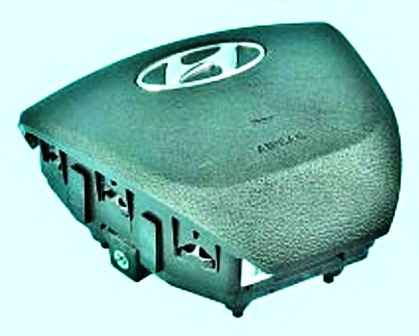
- the driver's airbag module, located in the steering wheel hub and consisting of a folded airbag shell and a gas generator;
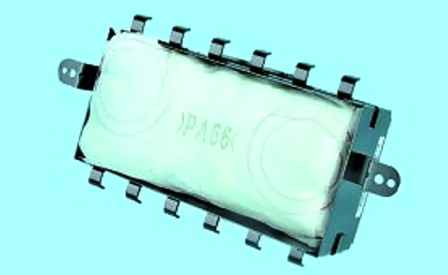
- front passenger airbag module, located in the instrument panel on the passenger side and consisting of a folded airbag shell and a gas generator.
Different from the driver's airbag in shape and large volume;
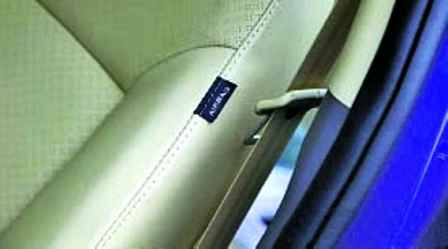
- - driver and front passenger side airbag modules located in the outer side parts of the front seat backrests and consisting of a folded airbag shell and a gas generator;
- - curtain airbag modules for the driver and passengers, located under the facings of the front and rear pillars of the body and consisting of a folded airbag shell and a gas generator;

Airbag locations are marked with an AIRBAG icon.
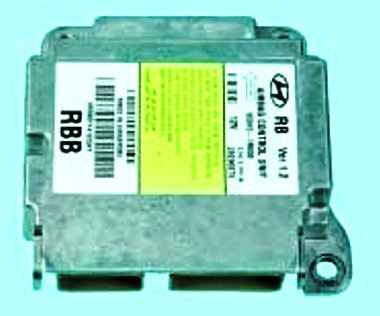
– an electronic control unit installed under the lining of the floor tunnel and controlling the system.
The ECU incorporates micromechanical sensors that measure the longitudinal and lateral acceleration of the car in a collision.
The ECU evaluates the impact force by comparing the values it receives from the front impact sensor, side impact sensors, and internal electronic sensors with a predetermined value.
If the deceleration signal due to a frontal or side impact exceeds a predetermined value, the computer will trigger the pretensioners and deploy the corresponding airbags.
If the vehicle's battery ruptured during the crash, the voltage holding circuit in the ECU would still be able to activate the airbags for some time after the impact;
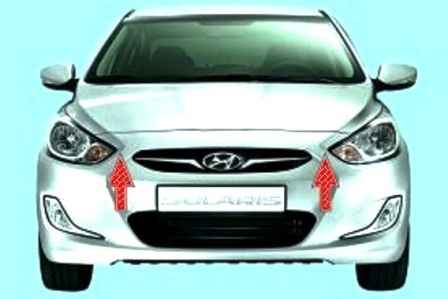
– frontal and side impact sensors that transmit acceleration information to the system control unit.
The force and direction of the impact in a traffic accident is determined by the electronic control unit of the passive safety system using impact sensors.
According to the signals from the sensors, the control unit activates the airbags and front seat belt pretensioners.
Front impact sensors are located on the side members of the car body behind the front bumper
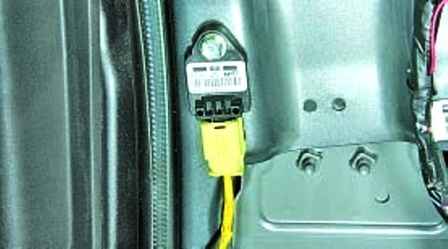
Side impact sensors are mounted on the B-pillar on the inside behind the pillar trims;
Side impact sensor shown, located on the left side of the vehicle.
Another sensor is located on the right side in a similar way.
Side impact sensors are installed on cars with side airbags and inflatable curtains in the variant.

- seat belts.
When a certain force is hit, the ECU, having received signals from the impact sensors, increases the tension of the belts before activating the airbags, issuing a command to the pyrotechnic elements of the pretensioners.
The latter provide a timely response to the emergency deceleration of the car, pulling the driver and front passenger to the seatbacks, exclude their further movement forward by inertia and injury from the deployed airbag;
The seat belt pretensioner mechanism always deploys before the airbag.

- head restraints, mouth updated on the backs of the driver's and front passenger's seats of cars of all trim levels and on the back of the rear seat.
Head restraints prevent occupants from getting hurt in the neck in the event of a severe rear impact or airbag deployment.
The front and rear seat head restraints can be adjusted in height by pressing the lock and moving the head restraint up or down to the desired height
The optimal position of the head restraint is when its upper edge is flush with the top of the head.
For very tall people, raise the head restraint to its highest position, for very short people, lower the head restraint to its lowest position.
- signaling devices of the passive safety system:

If the signaling device lights up, contact a specialized car service immediately.
In addition to the possible failure in an emergency, an airbag can deploy unexpectedly while driving and lead to serious consequences.

Removing the driver's airbag
Disconnect the negative cable from the battery
Wait at least one minute for the airbag activator capacitor to discharge
If the power is left on, the airbag may deploy unexpectedly
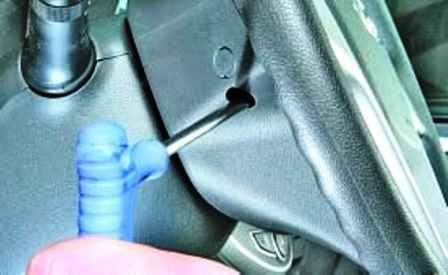
We unscrew the two screws securing the airbag module to the steering wheel and remove the screws
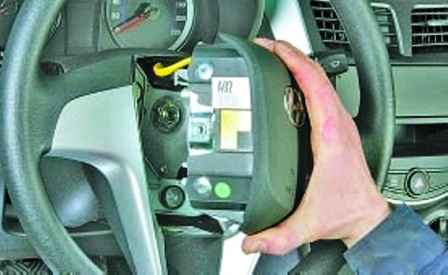
We take out the pillow module and take it to the length of the wires
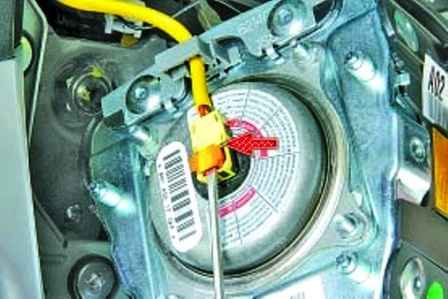
Use a screwdriver to pry the retainer of the wire block

Disconnect the wiring harness block from the module
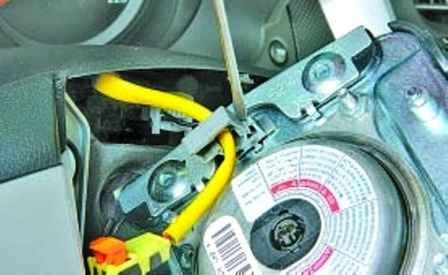
Use a screwdriver to press the holder of the wiring harness and remove the wire from the holder

Remove the airbag module
When installing the module in the steering wheel of the car, be outside the airbag deployment zone.
When turning on the ignition for the first time after installing the airbag module in the vehicle, be outside the vehicle and turn on the ignition switch by reaching under the steering column.
Removing and installing passenger airbag
Disconnect the negative cable from the battery
Wait at least one minute for the airbag activator capacitor to discharge
If the power is left on, the airbag may deploy unexpectedly

Remove the dashboard as described in the article - How to remove the dashboard (torpedo) of a Hyundai Solaris car

We unscrew the screws securing the front passenger airbag module to the instrument panel
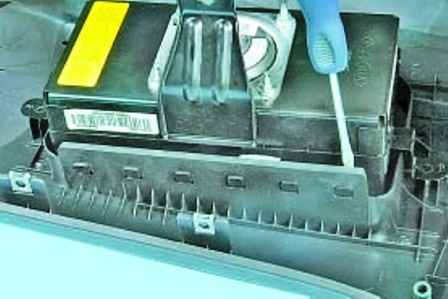
Using a screwdriver, we pry the cushion fasteners
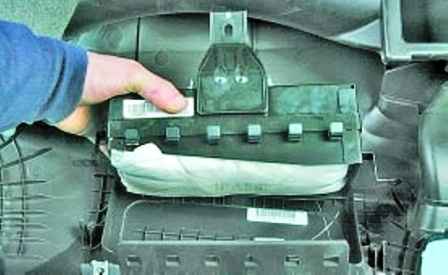
Remove the airbag module from the instrument panel

Install the pillow in reverse order
Removing the front seat belts
Disconnect the negative cable from the battery
Wait at least one minute for the airbag activator capacitor to discharge

We unscrew the bolt of the lower fastening of the seat belt behind the driver's seat

Remove the bolt, spacer, washer and move the belt to the side

Remove the lower part of the B-pillar lining

Remove the upper part of the lining of the central pillar, removing the buckles of the seat belt from the opening of the upper part of the lining
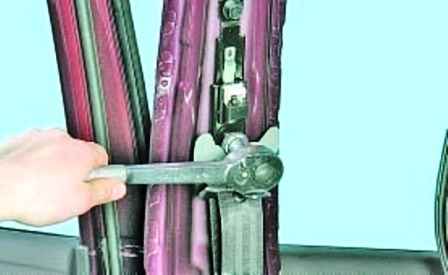
We unscrew the bolt of the upper fastening of the seat belt to the mechanism for adjusting the height of the belt
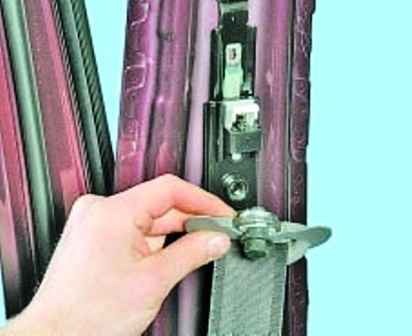
Remove the belt buckle from the height adjustment mechanism

Pry off the retainer of the seat belt pretensioner wire block
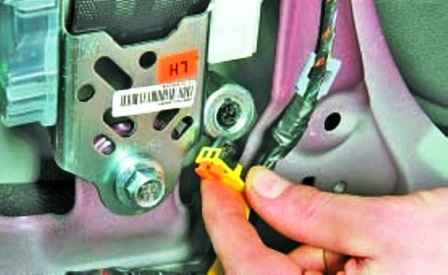
Remove the block of wires from the pretensioner
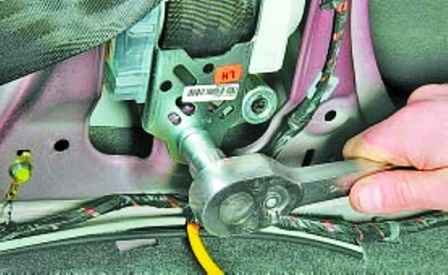
We unscrew the bolt securing the inertial seat belt reel to the body
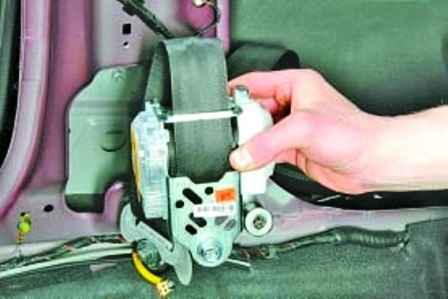
And remove the seat belt
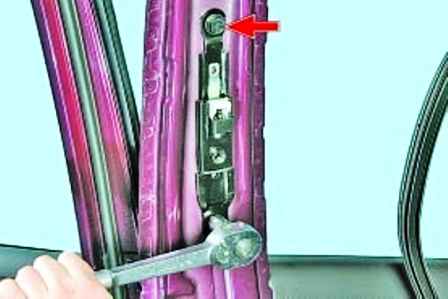
If it is necessary to replace the mechanism for adjusting the position of the belt in height, unscrew the two bolts of its fastening
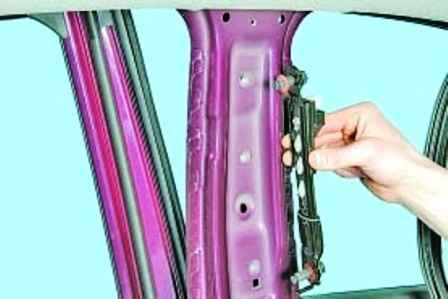
And remove the adjustment mechanism
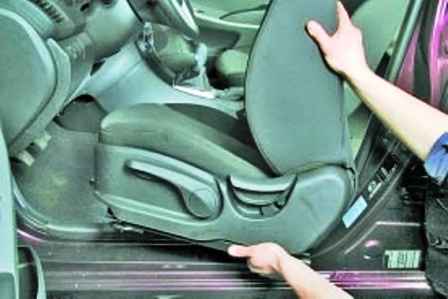
If you need to replace the front seat belt buckle, then remove the front seat
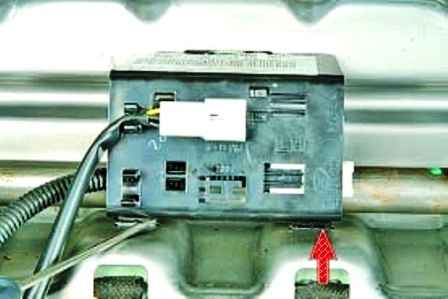
Using a screwdriver, we pry off the two fasteners for fastening the holder of the front seat heating pads and the seat belt sensor

Remove the pad holder
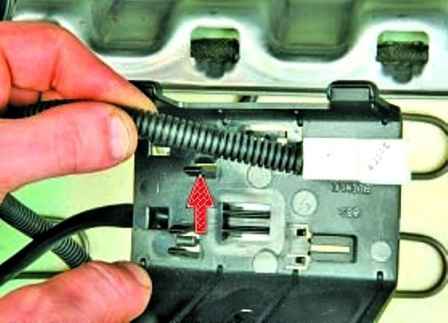
Unfold the holder and remove the seat belt sensor harness from the lock
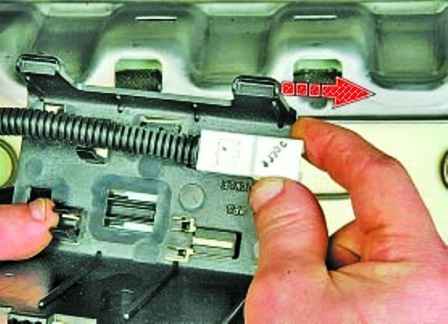
We pull the seat belt sensor harness block to the side (as shown in the photo)

And detach the block from the holder

Use a screwdriver to pry off the seat belt sensor wire holder
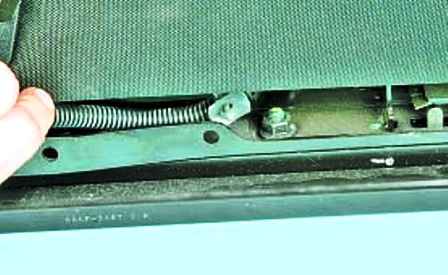
Disconnect the wiring harness from the seat base

Unscrew the bolt securing the seat belt buckle to the seat

And remove the belt buckle along with the wiring harness connected to it
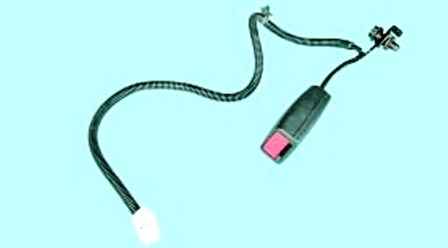
Install the seat belt buckle and all parts in reverse order
Removing and installing rear seat belts
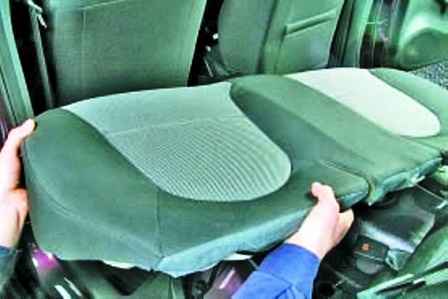
Remove the rear seat cushion

We unscrew the bolt of the rear passenger seat belt lower mounting
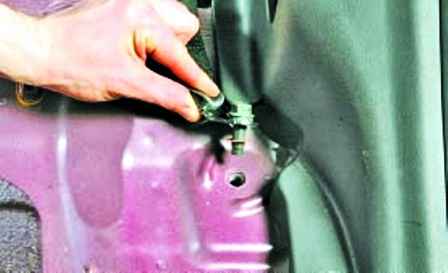
Remove the bolt

Remove the back of the rear seat, bringing the rear side seat belts out of the eyelets on the back of the rear seat
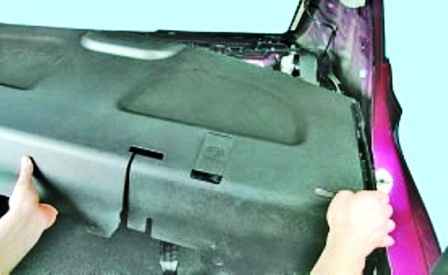
Remove the lining of the rear shelf
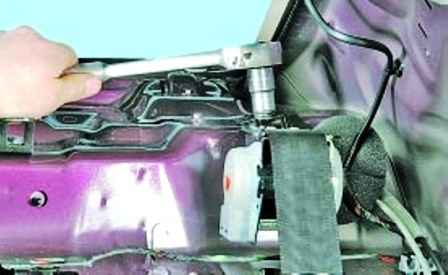
We unscrew the bolt securing the inertial seat belt reel to the body
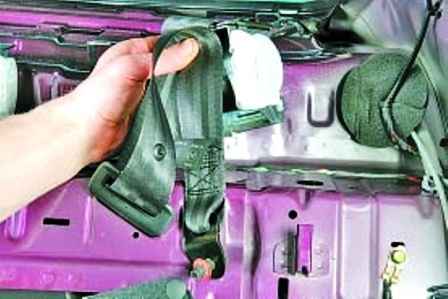
We disengage the inertial coil bracket from above and remove the rear passenger seat belt assembly
To replace the rear passenger seat belt buckles, press the rear left passenger seat belt sensor harness connector retainer and disconnect the sensor connectors.
Similarly, disconnect the seat belt sensor pads for the rear right and middle passengers.
Using a screwdriver, pry off and disconnect from the bottom of the body the block of the sensor for the unfastened seat belt of the rear left passenger
We also disconnect the block of the unfastened seat belt of the rear right and middle passenger

We unscrew the bolt securing the left rear passenger's seat belt buckle and the middle passenger's seat belt to the car body
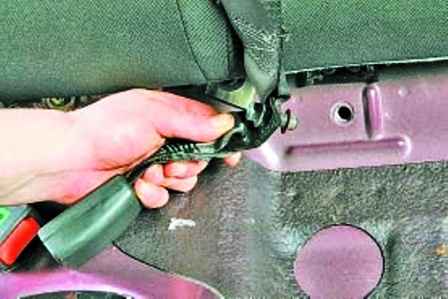
Remove Middle passenger seat belt buckle and rear left passenger seat belt buckle
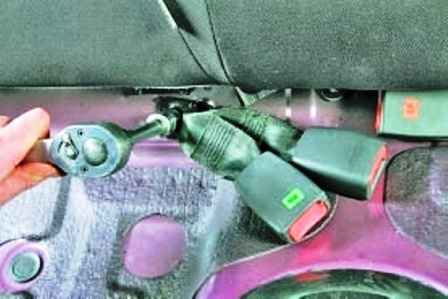
We unscrew the bolt securing the seat belt buckles of the middle and right passengers
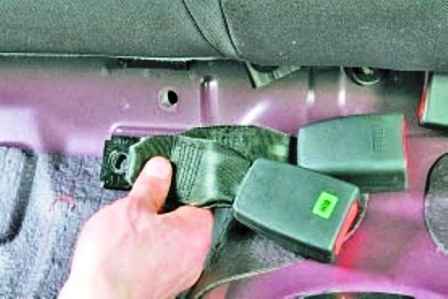
And remove the locks
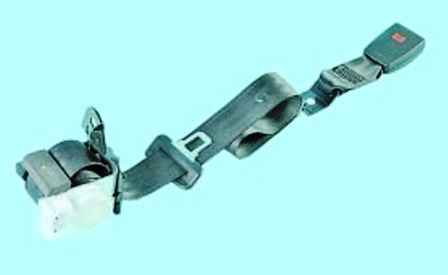
Install parts in reverse order





